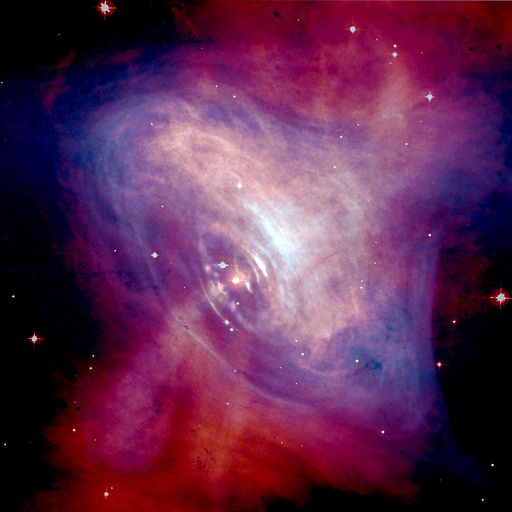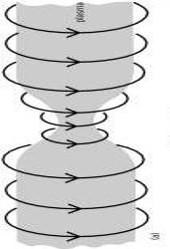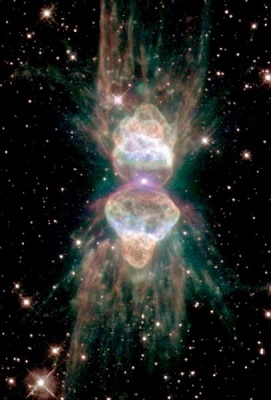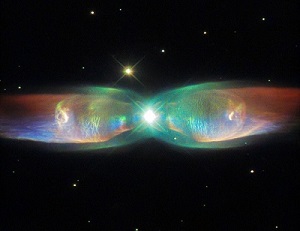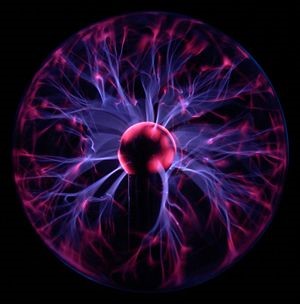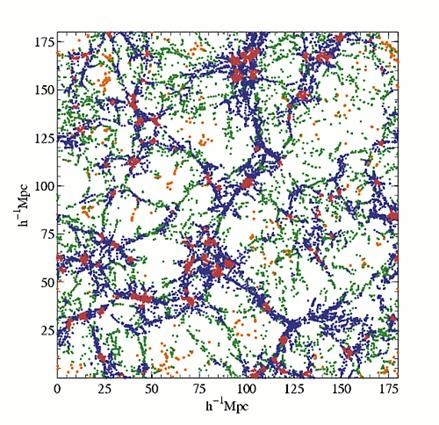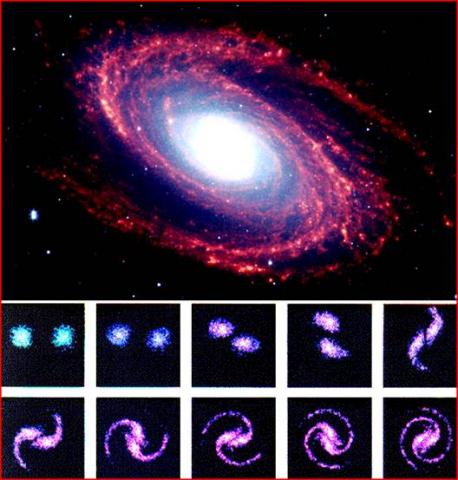The Big Stretch - Part 4 - Scientific Evidence
One might wonder whether there is any science to support the model described in the earlier articles in the Big Stretch series, especially after seeing how much it agrees with the Bible. In this short article, we take a look at the scientific evidence for this model.
This article is part of a continuing series about a cosmological model that integrates 2 scientific fields, each based on work of multiple Nobel prize winners. The resulting model, referred to here as the Setterfield model or the Setterfield ZPE-plasma model, is not only in agreement with laboratory results and astronomical observations, but is in amazing agreement with the oldest texts of Genesis. Last month we reviewed evidence for the agreement of this model with the Bible. That included the sun forming on day 4 of creation week, light on day 1, and the earth forming before the sun. See part 3 of the series (http://tasc-creationscience.org/article/big-stretch-3) for more Biblical evidence, and part 1 (http://tasc-creationscience.org/article/big-stretch-1) for a general introduction to this model.
In this article, we will look at the scientific evidence that supports this model.
The Name "Big Stretch"
This series of articles uses the name Big Stretch. Why?
One thing the Big Bang and the model described in these articles have in common is they both involve an expansion of the universe. The Bible also refers to the heavens being stretched out; therefore, these articles concerning the beginning of the universe are named the Big Stretch, somewhat like the name of the Big Bang.
When the heavens were stretched out, per this model, energy was poured into the cosmos. This energy manifested initially as Planck Particle Pairs, PPP, the smallest possible particles of matter, much smaller than atoms or electrons. 1 The energy of these PPPs then over time transformed into the Zero Point Energy (ZPE). This conversion continued even after the expansion was completed. As the ZPE built up, in a sense, space became "thicker" and this slowed light, even as light slows when passing through water or glass; this slowing in both cases is for the same reason, namely, the absorption and reemission of photons by the particles of the glass, water, or by the virtual particles of the ZPE.
According to the Setterfield ZPE-plasma cosmology, the stretching or expansion ended about 650 to 700 years after Creation, and the increase in the ZPE continued until about 3500 years after creation. 2 The reason for the increase in the ZPE is because of ongoing turbulence among the PPP. 3 ,4
So initially PPPs built up, then they decreased as the ZPE built up. This would have consequences that observational data can confirm. We will return to this point later.
How Did the Solar System and Galaxies Form?
Per this model, there are plasma filaments, or Birkeland currents, in space. 5 6 7 These filaments can be huge - they can connect stars and even galaxies, and even clusters of galaxies. In fact, when these filaments contract or pinch in what is known as a Z-pinch or Bennet pinch, 8 per this model, the forces in play squeeze the matter together, creating stars and galaxies. These filaments can separate into smaller filaments. When this happens, the ionization potential of the elements of the periodic table will determine which elements get separated into regions near the axis of the filament, and which other elements get concentrated into the regions farther away from the axis. This process will predictably result in concentrations of certain elements in various regions, based on distance from the central axis and on the ionization potentials of the constituent elements. Thus, the outer planets that were formed by the outer subfilaments should have a different composition than the inner planets. What we find in the solar system matches this perfectly, from Mercury out to the gas giants. 9 10
This model predicts that the outer filaments will form planets first, before the central filament forms the star that later lights up. This is why the model predicted, as stated in the previous article of the series, that the sun would light up after the planets formed. The sun lights up when it is formed by the electromagnetic forces "pinching" the central filament together. We see this process in space, where stars seem to be forming, as shown in the images below (Figures 2, 3 and 4).
We can see the filaments of plasma in the plasma ball in Figure 5. Compare the filaments of the plasma ball with the filaments in space, on a much larger scale (Figure 6). The structure of both is similar. In Figure 6, showing galactic scale filaments, the red dots are galaxy clusters. The blue lines are filaments connecting the galactic clusters. So, filaments in the universe exist even at the scale of galaxies and clusters of galaxies, very large scales indeed! The idea that such structure could exist at such large scales was proposed by Nobel prize winner Hannes Alfven years before it was actually discovered. When it was later discovered, astronomers were puzzled and surprised. But this is not surprising to those familiar with the plasma cosmology that we are describing in this article.
What is the nature of these filaments? Basically, they are currents - electric currents. How can this be - there are no wires in space! But there can be currents without wires. We may have heard of the solar wind - this consists of charged particles. Moving charged particles constitute a current; in fact, this is the definition of electric current.
Also, we need to consider that the universe is 99% plasma, and plasma consists of electrically charged particles, sometimes referred to as the 4th state of matter. We have solid, liquid, and gas. The thing that sets plasma apart from those other states of matter is that solids, liquids, and gases are composed of atoms and molecules that are electrically neutral. Plasma, by definition, consists of electrically charged particles. And the universe is 99% plasma! We note that virtually everything in space is moving: planets orbit the sun, moons orbit planets, stars move in their galaxies as the galaxy rotates, galaxies move with respect to each other, there is a solar wind, etc. And the vast majority of this moving matter is plasma - charged particles. Electric current is by definition, moving charged particles. We should therefore not be surprised that there are electric currents in space. Recently large currents flowing in space have been detected.
Professor Emeritus of Electrical Engineering Donald Scott, of the University of Massachusetts, Amherst, has explained how such currents can exist without wires in space. 11 The forces in Birkeland currents have been shown by Dr. Scott to "squeeze" charged particles into concentric cylinders of the electric current, as seen in Figures 2 to 4. The math gets a little complicated, involving Bessel Functions, and apparently was only partially understood until Dr. Scott published his paper. 12 We know they exist, since we have the Auroras on earth, which are caused by such electric currents (Birkeland currents). 13
Supporting Scientific Evidence
Below is a list of some supporting evidence from science for this model.
Galaxy Rotation
One mystery about galaxies has been why the outer parts rotate at about the same rate as the center. The conventional explanation for this fails, which is why dark matter has been hypothesized to try to account for it; however, the measured galaxy rotation rate gradients are not in conflict with the Setterfield ZPE-plasma model, which expects such.
Galaxy Formation
The Setterfield model predicts galaxies in the same morphology (structure / shape) as is actually observed. This same structure has been observed in laboratory experiments simulating the interaction of plasma filaments, resulting in the various shapes of every known type of galaxy (Figure 7). 14 Setterfield says of plasma physicist Anthony Peratt, that "He was able to show that laboratory experiments with plasma filaments can form miniature galaxies of all types." 15
Top: Spitzer telescope image of galaxy M81.
Bottom: Looking down the long axis of two interacting plasma filaments in the lab which produced miniature galaxies. Simulations included up to 12 interacting filaments, but all galaxy types can be produced with two or three filaments. Compare with M81 at top: Stars form along plasma filaments making up the spiral arms like beads on a string due to plasma pinch effects, like the 3 final frames at bottom.
Planetary Composition
According to this model, the inner planets would have higher tendencies for rocky cores to constitute a higher percent of their volume, and outer planets would tend to have more helium. This is due to a process known as Marklund convection. This composition of the planets is precisely what is observed in our solar system, from Mercury out to the gas giants. 16
Fuzziness of Distant Space
According to this model, distant space should seem somewhat fuzzy or foggy. As mentioned earlier in this article, the number of PPPs was larger in the past. The fogginess is due to this larger number of PPP in the past distorting objects viewed by light passing through these PPPs. Setterfield says ...
These particles were initially postulated by Planck early in the 20th century. However they were not studied seriously until fifty years later. A lot of recent work has been done by Gibson and Daywitt. The evidence for their previous existence is a sort of 'fogginess' which exists everywhere we look at the farthest reaches of space. In the same way our atmosphere causes the stars to twinkle, the PPP 'fog' causes the distant quasars to 'twinkle.' 17
Red Shift Evidence
Quantization of Red Shift
The Setterfield ZPE-plasma cosmology requires that the red shift we see be due to the different energy levels of atomic orbitals in the past, not due to the conventional Doppler effect or expansion of space. This changing atomic energy has to be quantized, as physicists today well know. Therefore this model accounts for a quantized red shift, for distant galaxies. Has this been observed? Yes, as explained in the following abstract of an article by Napier and Guthries:
The current status of a continuing programme of tests for redshift periodicity or ‘quantization’ of nearby bright galaxies is described. So far the redshifts of over 250 galaxies with high-precision HI profiles have been used in the study. In consistently selected sub-samples of the datasets of sufficient precision examined so far, the redshift distribution has been found to be strongly quantized in the galactocentric frame of reference. The phenomenon is easily seen by eye and apparently cannot be ascribed to statistical artefacts, selection procedures or flawed reduction techniques. ... The formal confidence levels associated with these results are extremely high. 18
Amount of Quantization of Red Shift
In addition to the basic concept that the red shift is quantized, the specific amount of quantization from measurement is in agreement with the Setterfield ZPE-plasma model to 3 significant figures. 19
Apparent Centering of Red Shift "Shells" on Earth
The regions separated by different red shift values have been found to exist in concentric shells, which seem to have earth at their center. This has led to some theories that the earth or our galaxy is the center of the universe, which seems very unlikely from a strictly statistical viewpoint. However, instead of the apparent centering of these shells on earth being due to the placement of these regions in space, what if it is due to their age; the older the region being observed, the greater its red shift? Then, regardless of where earth is located in the universe, the farther regions will always have greater red shifts, and the nearer regions less; and, as noted above, this red shift is quantized. Thus there will always appear to be shells surrounding the earth representing different ages of those regions surrounding the earth. This model explains this situation as something to be expected, not a mystery to be solved.
Blue shifts
Some blue shifts have been observed, when per conventional models, red shift would be expected. Expansion of the universe would cause a red shift; how can there be a blue shift, the opposite, if the universe is expanding? This is a real problem for models that suggest that the universe is currently expanding.
However, the Big Stretch model tells us that the universe is no longer expanding, but oscillating, and that the far away galaxies should have red shift, due to the physical effects in the early universe which are being observed in distant astronomical objects. Nearby galaxies should have less red shift, and for some nearby ones the Doppler effect can come into play, since the effect of the changing ZPE is not present to overpower it. 20 Thus blue shifts are accounted for in this model, while constituting a problem for the conventional models.
Population I and II stars
Population I stars are hotter, younger, and tend to contain more heavy elements than Population II stars. 21 The time difference between the appearance of these two types of stars as measured by astronomers, assuming constant light speed, is about 4 billion years. 22 (NOTE: the Setterfield ZPE-plasma model does not agree with this age, but with a much younger age; however, it does agree with this apparent age.) This measurement matches the time calculated, per this model. 23
Quasar Energy Gradient with Respect to Distance from Earth
Quasars are objects that output extremely large amounts of energy, and are the most luminous objects in the universe. Some are are more luminous than entire galaxies. 24 Quasars are not large black holes in the Setterfield ZPE-plasma cosmology, however, but plasma phenomena. 25 26 It has been observed that more distant quasars tend to be more energetic. Again, this is due to their age, not their distance, per this model. And this is exactly what is to be expected from this model. In the early universe, the differing level of ZPE would cause the magnetic permeability of the vacuum of space and the electric permittivity of space, to be different, resulting in some processes of physics to work somewhat differently, so that quasars would be expected to put out more energy in the early universe.
Pioneer 10 and 11 Acceleration Anomaly
There is a strange problem with the measured behavior of Pioneer 10 and 11, Ulysses and Galileo. 27 Setterfield explains this as possibly due to a changing c, which is consistent with his model, rather than due to a changing acceleration. From the equations involved, ...
... the term (2at/c) is the cause of the dilemma. Since t is known, and it has been assumed that c is known, the only option has been to consider that the term a, the acceleration, is the source of the problem. However, the option which has not been considered has been that a is behaving just as predicted and that lightspeed, c, is changing. 28
Alignment of Quasar Spin Axes
Alignment of quasar spin axes has been reported:
When astronomers look at the distribution of galaxies on scales of billions of light-years they find that they are not evenly distributed.
They form a cosmic web of filaments and clumps around huge voids where galaxies are scarce. This intriguing and beautiful arrangement of material is known as large-scale structure.
The new VLT results indicate that the rotation axes of the quasars tend to be parallel to the large-scale structures in which they find themselves.
So, if the quasars are in a long filament then the spins of the central black holes will point along the filament.
The researchers estimate that the probability that these alignments are simply the result of chance is less than one per cent. 29 30
This model holds that galaxies and stars formed from Bennet pinches of plasma / Birkeland currents in space, and that quasars form in the center of galaxies, spinning along the same spin axis. Recently astronomers have noted and commented that stars seem to form along filaments. Galaxies also seem to be formed along filaments, and what is more, their spin axes seem to align with the filaments. This is to be expected if those galaxies formed as per this model.
Alignment of Galactic Spin Axes
Galactic spin axes would be expected to be aligned according to the Setterfield ZPE-plasma model. The reason is basically the same as that above, since per this model, quasars are plasmoids at the centers of galaxies. 31
Summary
More could be added to the above; due to space limitations, I will not include it all here. However, we see that this model agrees with many observations that give problems for conventional models. In light of the above, with the other evidence given in other articles of this series, there is strong evidential support for this model. To read more, see http://www.barrysetterfield.org/ and the book by Setterfield (http://www.barrysetterfield.org/GSRdvds.html#cosmology).
- 1Setterfield B (2008) A plasma universe with the zero point energy. http://www.barrysetterfield.org/PlasmaU_with_ZPE.html Accessed 2017 Aug 21
- 2Setterfield B, personal communication.
- 3Gibson CH (2001) Turbulence and mixing in the early universe. ICME2001. http://arxiv.org/pdf/astro-ph/0110012v3.pdf Accessed 2017 Aug 21
- 4Setterfield B. (2012) Zero point energy, light and time. Proc Natural Philosophy Allliance 9:528 http://www.barrysetterfield.org/ZPE_light_time/ZPE_light_and_time.html Accessed 2017 Aug 21
- 5Peratt A. (1996) Electric space: Evolution of the plasma universe, Astrophysics and Space Science 244: 89-103, http://adsabs.harvard.edu/abs/1996Ap%26SS.244...89P Accessed 2017 Aug 21
- 6Scott D. (2015) Birkeland currents: A force-free field-aligned model, Prog Physics 11(2):167-179 https://progress-in-physics.com/2015/PP-41-13.PDF Accessed 2017 Aug 27
- 7Birkeland current http://www.plasma-universe.com/Birkeland_current Accessed 2017 Aug 21
- 8Z-pinch https://en.wikipedia.org/wiki/Z-pinch Accessed 2017 Aug 21
- 9Setterfield B. (2015) Plasma physics, astronomy and the ZPE model http://www.barrysetterfield.org/Plasma_Astronomy_ZPE/text.html Accessed 2017 Aug 21
- 10Marklund GT (1979) Plasma convection in force-free magnetic fields as a mechanism for chemical separation in cosmical plasmas. Nature 277:370-371 http://www.nature.com/nature/journal/v277/n5695/abs/277370b0.html?foxtrotcallback=true Accessed 2017 Aug 21
- 11Dr. Donald Scott: A New Model of Magnetic Structure in Space | EU2014, https://www.youtube.com/watch?v=uKG7HFM21Qk Accessed 2017 Aug 21
- 12Scott D. (2015) Birkeland currents: A force-free field-aligned model, Prog Physics 11(2):167-179 http://progress-in-physics.com/2015/PP-41-13.PDF Accessed 2017 Aug 27
- 13Kristian Birkeland. https://en.wikipedia.org/wiki/Kristian_Birkeland#Legacy Accessed 2017 Aug 21
- 14Image and caption from Fig. 11, http://www.barrysetterfield.org/ZPE_light_time/ZPE_light_and_time.html#plasma
- 15Setterfield B, Setterfield H. Plasma or Gravity? http://www.barrysetterfield.org/Plasma_or_Gravity.html Accessed 2017 Aug 21
- 16Setterfield B (2008) A plasma universe with the zero point energy. http://www.barrysetterfield.org/PlasmaU_with_ZPE.html Accessed 2017 Aug 21
- 17Setterfield B, Setterfield H (2009) Data and creation: The ZPE-plasma model. http://www.barrysetterfield.org/Data_and_Creation/ZPE-Plasma_model.html#fabric Accessed 2017 Aug 21
- 18Napier WΜ, Guthrie BNG (1997) Quantized redshifts: A status report. J Astrophys Astr 18:455–463 http://www-old.ias.ac.in/jarch/jaa/18/455-463.pdf Accessed 2017 Aug 21
- 19Setterfield B, The ZPE and the redshift, http://www.barrysetterfield.org/behaviorzpe5.html#redshifts55 Accessed 2017 Aug 21
- 20Setterfield B. The red shift. http://www.barrysetterfield.org/redshift.htm#blueshifts Accessed 2017 Aug 21
- 21Physics and Astronomy Department, Georgia State University, Populations I and II stars http://hyperphysics.phy-astr.gsu.edu/hbase/Starlog/pop12.html Accessed 2017 Aug 27
- 22Setterfield B, A brief stellar history, http://www.barrysetterfield.org/Brief_stellar.html#ages Accessed 2017 Aug 21
- 23Setterfield B. Creation and Plasma Physics http://www.barrysetterfield.org/Creation_and_Plasma_Physics.htm
- 24Quasar. https://en.wikipedia.org/wiki/Quasar Accessed 2017 Aug 27
- 25Setterfield B, Explanations and interpretations: Galaxy cores and galaxy formation http://www.barrysetterfield.org/Astronomy/Galaxy_Cores.html Accessed 2017 Aug 27
- 26Setterfield B, Galaxies http://www.barrysetterfield.org/Astronomy/Galaxies.html#quasars Accessed 2017 Aug 27
- 27Anderson JD, Laing PA, Lau EL, Liu AS, Nieto MM, Turyshev SG (2005) Study of the anomalous acceleration of Pioneer 10 and 11 https://arxiv.org/pdf/gr-qc/0104064.pdf Accessed 2017 Aug 21
- 28Setterfied B, (2003) Pioneer 10 and 11 acceleration anomaly. http://www.barrysetterfield.org/accelanom.htm Accessed 2017 Aug 21
- 29Setterfield B (2014) Quasar axes aligned along filaments http://www.barrysetterfield.org/Astronomy/Quasar_alignments.html Accessed 2017 Aug 21
- 30Zolfagharifard E (2014) Mystery of the 'spooky' pattern in the universe: Scientists find that supermassive black holes are aligned. http://www.dailymail.co.uk/sciencetech/article-2842418/Mystery-spooky-pattern-universe-Scientists-supermassive-black-holes-aligned.html Accessed 2017 Aug 21
- 31Setterfield B. Quasar axes aligned along filaments http://www.barrysetterfield.org/Astronomy/Quasar_alignments.html
